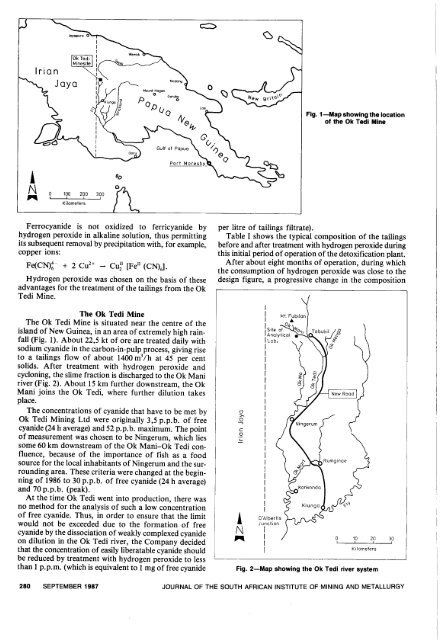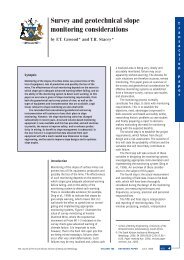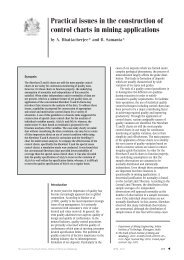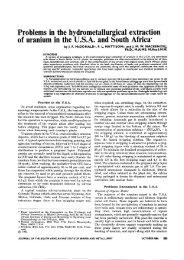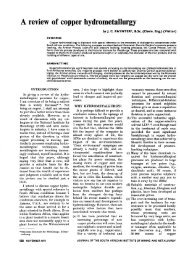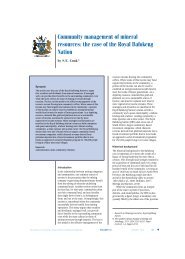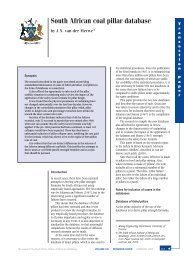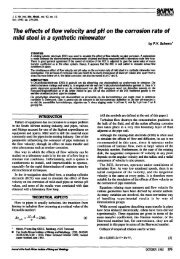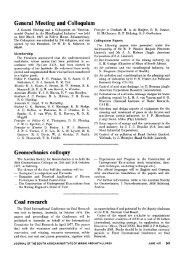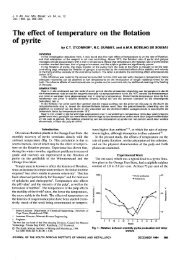The detoxification of gold-mill tailings with hydrogen peroxide - saimm
The detoxification of gold-mill tailings with hydrogen peroxide - saimm
The detoxification of gold-mill tailings with hydrogen peroxide - saimm
You also want an ePaper? Increase the reach of your titles
YUMPU automatically turns print PDFs into web optimized ePapers that Google loves.
c:::::><br />
Fig. 1-Map showing the location<br />
<strong>of</strong> the Ok Tedi Mine<br />
,<br />
N<br />
"<br />
,<br />
0, 100 200 300<br />
Kilometers<br />
, ,<br />
00<br />
Ferrocyanide is not oxidized to ferricyanide by<br />
<strong>hydrogen</strong> <strong>peroxide</strong> in alkaline solution, thus permitting<br />
its subsequent removal by precipitation <strong>with</strong>, for example,<br />
copper ions:<br />
Fe(CN)t + 2 Cu2+- CU~I[Fell (CN)6]'<br />
Hydrogen <strong>peroxide</strong> was chosen on the basis <strong>of</strong> these<br />
advantages for the treatment <strong>of</strong> the <strong>tailings</strong> from the Ok<br />
Tedi Mine.<br />
per litre <strong>of</strong> <strong>tailings</strong> filtrate).<br />
Table I shows the typical composition <strong>of</strong> the <strong>tailings</strong><br />
before and after treatment <strong>with</strong> <strong>hydrogen</strong> <strong>peroxide</strong> during<br />
this initial period <strong>of</strong> operation <strong>of</strong> the <strong>detoxification</strong> plant.<br />
After about eight months <strong>of</strong> operation, during which<br />
the consumption <strong>of</strong> <strong>hydrogen</strong> <strong>peroxide</strong> was close to the<br />
design figure, a progressive change in the composition<br />
<strong>The</strong> Ok Tedi Mine<br />
<strong>The</strong> Ok Tedi Mine is situated near the centre <strong>of</strong> the<br />
island <strong>of</strong> New Guinea, in an area <strong>of</strong> extremely high rainfall<br />
(Fig. 1). About 22,5 kt <strong>of</strong> ore are treated daily <strong>with</strong><br />
sodium cyanide in the carbon-in-pulp process, giving rise<br />
to a <strong>tailings</strong> flow <strong>of</strong> about 1400 m3/h at 45 per cent<br />
solids. After treatment <strong>with</strong> <strong>hydrogen</strong> <strong>peroxide</strong> and<br />
cycloning, the slime fraction is discharged to the Ok Mani<br />
river (Fig. 2). About 15 km further downstream, the Ok<br />
Mani joins the Ok Tedi, where further dilution takes<br />
place.<br />
<strong>The</strong> concentrations <strong>of</strong> cyanide that have to be met by<br />
Ok Tedi Mining Ltd were originally 3,5 p.p.b. <strong>of</strong> free<br />
cyanide (24 h average) and 52 p. p. b. maximum. <strong>The</strong> point<br />
<strong>of</strong> measurement was chosen to be Ningerum, which lies<br />
some 60 km downstream <strong>of</strong> the Ok Mani-Ok Tedi confluence,<br />
because <strong>of</strong> the importance <strong>of</strong> fish as a food<br />
source for the local inhabitants <strong>of</strong> Ningerum and the surrounding<br />
area. <strong>The</strong>se criteria were changed at the beginning<br />
<strong>of</strong> 1986 to 30 p.p.b. <strong>of</strong> free cyanide (24 h average)<br />
and 70 p.p.b. (peak).<br />
At the time Ok Tedi went into production, there was<br />
no method for the analysis <strong>of</strong> such a low concentration<br />
<strong>of</strong> free cyanide. Thus, in order to ensure that the limit<br />
would not be exceeded due to the formation <strong>of</strong> free<br />
cyanide by the dissociation <strong>of</strong> weakly complexed cyanide<br />
on dilution in the Ok Tedi river, the Company decided<br />
that the concentration <strong>of</strong> easily liberatable cyanide should<br />
be reduced by treatment <strong>with</strong> <strong>hydrogen</strong> <strong>peroxide</strong> to less<br />
than 1 p.p.m. (which is equivalent to 1 mg <strong>of</strong> free cyanide<br />
0<br />
>- 0<br />
--,<br />
c<br />
0<br />
'-<br />
!<br />
N<br />
10 , 20,<br />
"<br />
Kilometers<br />
Fig. 2-Map showing the Ok Tedi river system<br />
30,<br />
280 SEPTEMBER 1987 JOURNAL OF THE SOUTH AFRICAN INSTITUTE OF MINING AND METALLURGY


